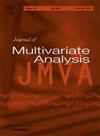利用全局和局部马氏距离进行分类
IF 1.4
3区 数学
Q2 STATISTICS & PROBABILITY
引用次数: 0
摘要
我们提出了一种基于观测值与竞争类之间的马氏距离的半参数分类器。我们的工具是一个具有逻辑链接函数的广义加性模型,该模型使用这些距离作为特征来估计不同类别的后验概率。虽然流行的参数分类器,如线性和二次判别分析,主要是由底层分布的正态性驱动的,但本文提出的分类器更灵活,不受这些参数建模假设的影响。由于椭圆分布的密度是马氏距离的函数,所以当竞争类(接近)椭圆时,该分类器工作得很好。在这种情况下,它通常优于流行的非参数分类器,特别是当样本大小与数据的维度相比较小时。为了处理非椭圆和可能的多模态分布,我们提出了马氏距离的局部版本。随后,我们提出了另一种基于广义加性模型的分类器,该模型使用局部马氏距离作为特征。当底层分布为椭圆型时,这种非参数分类器的性能通常与基于马氏距离的半参数分类器相似,但在一些非椭圆型和多模态分布下,其性能优于马氏距离分类器。我们还研究了这两个分类器在高维、低样本量情况下的行为。一项涉及多个模拟和真实数据集的全面数值研究表明,与许多最先进的方法相比,所提出的分类器是有用的。本文章由计算机程序翻译,如有差异,请以英文原文为准。
Classification using global and local Mahalanobis distances
We propose a novel semiparametric classifier based on Mahalanobis distances of an observation from the competing classes. Our tool is a generalized additive model with the logistic link function that uses these distances as features to estimate the posterior probabilities of different classes. While popular parametric classifiers like linear and quadratic discriminant analyses are mainly motivated by the normality of the underlying distributions, the proposed classifier is more flexible and free from such parametric modeling assumptions. Since the densities of elliptic distributions are functions of Mahalanobis distances, this classifier works well when the competing classes are (nearly) elliptic. In such cases, it often outperforms popular nonparametric classifiers, especially when the sample size is small compared to the dimension of the data. To cope with non-elliptic and possibly multimodal distributions, we propose a local version of the Mahalanobis distance. Subsequently, we propose another classifier based on a generalized additive model that uses the local Mahalanobis distances as features. This nonparametric classifier usually performs like the Mahalanobis distance based semiparametric classifier when the underlying distributions are elliptic, but outperforms it for several non-elliptic and multimodal distributions. We also investigate the behavior of these two classifiers in high dimension, low sample size situations. A thorough numerical study involving several simulated and real datasets demonstrate the usefulness of the proposed classifiers in comparison to many state-of-the-art methods.
求助全文
通过发布文献求助,成功后即可免费获取论文全文。
去求助
来源期刊

Journal of Multivariate Analysis
数学-统计学与概率论
CiteScore
2.40
自引率
25.00%
发文量
108
审稿时长
74 days
期刊介绍:
Founded in 1971, the Journal of Multivariate Analysis (JMVA) is the central venue for the publication of new, relevant methodology and particularly innovative applications pertaining to the analysis and interpretation of multidimensional data.
The journal welcomes contributions to all aspects of multivariate data analysis and modeling, including cluster analysis, discriminant analysis, factor analysis, and multidimensional continuous or discrete distribution theory. Topics of current interest include, but are not limited to, inferential aspects of
Copula modeling
Functional data analysis
Graphical modeling
High-dimensional data analysis
Image analysis
Multivariate extreme-value theory
Sparse modeling
Spatial statistics.
 求助内容:
求助内容: 应助结果提醒方式:
应助结果提醒方式:


